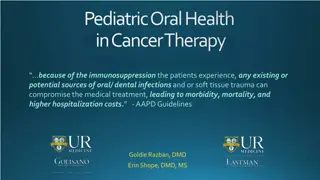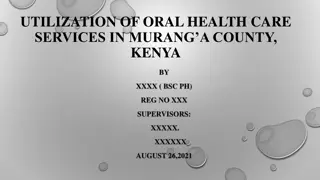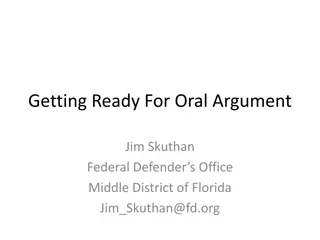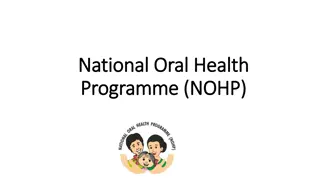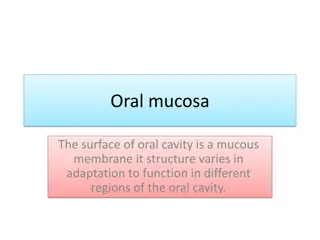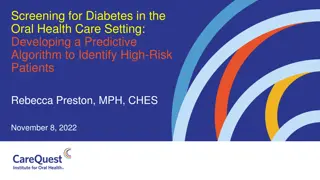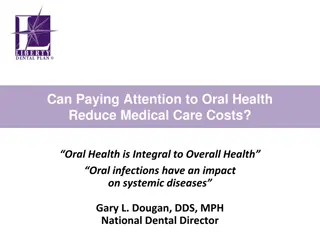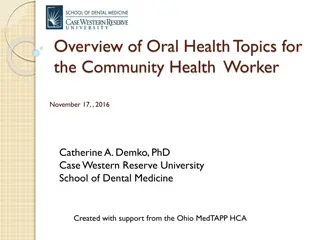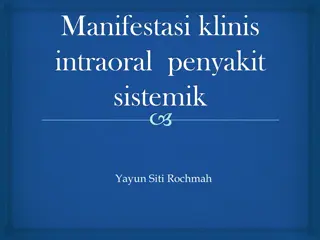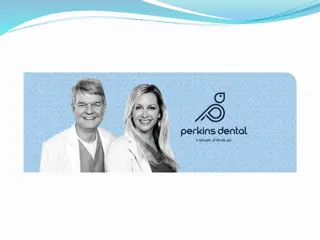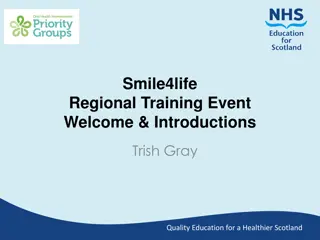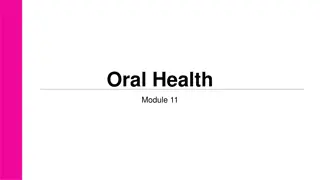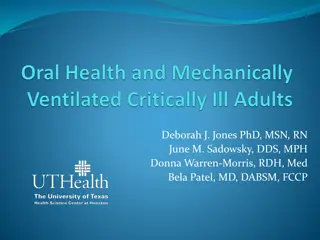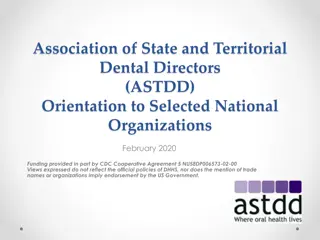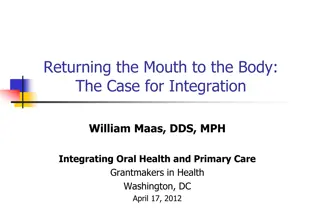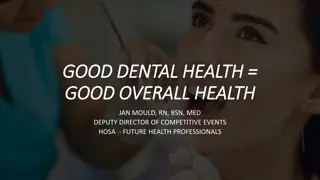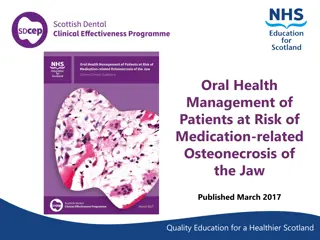Enhancing Oral Health Awareness: Effective Communication Strategies
Explore communication strategies to engage your community and promote oral health awareness, focusing on using plain language, presenting data effectively, engaging the public proactively, and leveraging social media. Understand the importance of clear communication in promoting oral health, and learn to avoid clinical jargon to reach a broader audience. Don't assume terms are universally understood, and adapt your language to enhance public comprehension.
Download Presentation

Please find below an Image/Link to download the presentation.
The content on the website is provided AS IS for your information and personal use only. It may not be sold, licensed, or shared on other websites without obtaining consent from the author.If you encounter any issues during the download, it is possible that the publisher has removed the file from their server.
You are allowed to download the files provided on this website for personal or commercial use, subject to the condition that they are used lawfully. All files are the property of their respective owners.
The content on the website is provided AS IS for your information and personal use only. It may not be sold, licensed, or shared on other websites without obtaining consent from the author.
E N D
Presentation Transcript
Raising local oral health awareness Communication strategies to engage your community and promote KOHA A presentation by Matt Jacob to local health leaders in California October 22, 2019
My objectives 1. Demonstrate the importance of using plain language to promote KOHA 2. Show ways to present oral health data that enhance the public s ability to understand why KOHA matters 3. Offer suggestions for proactive ways to engage the public to raise awareness of KOHA and oral health 4. Recommend strategies for using social media to complement your other communication activities
Using plain language to promote KOHA and oral health
U.S. adult literacy levels 80 71.4M 70 65.1M 60 Millions of U.S. adults 50 40 30 26.6M 26.5M 20 16.6M 10 0 Very low or Low literacy Mid-level Moderate unable to skills measure High levels literacy to high (Source: Adult Literacy in the United States, DataPoint, U.S. Department of Education, July 2019; researchers used the Program for the International Assessment of Adult Competencies (PIACC) testing methodology, with adults between the ages of 18 and 65.)
U.S. adult literacy levels 80 108 million adults 71.4M 70 65.1M 60 Millions of U.S. adults 50 40 30 26.6M 26.5M 20 16.6M 10 0 Very low or Low literacy Mid-level Moderate unable to skills measure High levels literacy to high (Source: Adult Literacy in the United States, DataPoint, U.S. Department of Education, July 2019; researchers used the Program for the International Assessment of Adult Competencies (PIACC) testing methodology, with adults between the ages of 18 and 65.)
Avoid clinical and technical terms Write and talk to the public using plain language (Source: Jessica Ridpath, Got plain language? 5 tips for clear, engaging writing even in research, Group Health Research Institute, posted on Medium.com, Oct. 17, 2016)
Dont assume your terms are understood Many terms commonly used by the public health community may not be understood or may be misunderstood by the public: Health outcomes Surveillance data Dental utilization
Write clearly and concisely Clarity means shorter sentences (under 25 words) (Sources: Everyday Words for Public Health Communication, CDC, May 2016; Cornelia Dean, Am I Making Myself Clear? A Scientist s Guide to Talking to the Public, Harvard Univ. Press: Cambridge, Mass., 2009; A Way with Words: Guidelines for Writing Oral Health Materials for Audiences with Limited Literacy, National Maternal and Child Oral Health Resource Center, 2004.)
Write clearly and concisely Clarity means shorter sentences (under 25 words) Clarity means shorter paragraphs (under 100 words) (Sources: Everyday Words for Public Health Communication, CDC, May 2016; Cornelia Dean, Am I Making Myself Clear? A Scientist s Guide to Talking to the Public, Harvard Univ. Press: Cambridge, Mass., 2009; A Way with Words: Guidelines for Writing Oral Health Materials for Audiences with Limited Literacy, National Maternal and Child Oral Health Resource Center, 2004.)
Write clearly and concisely Clarity means shorter sentences (under 25 words) Clarity means shorter paragraphs (under 100 words) Clarity means deleting lazy words words that take up space but aren t necessary for understanding (Sources: Everyday Words for Public Health Communication, CDC, May 2016; Cornelia Dean, Am I Making Myself Clear? A Scientist s Guide to Talking to the Public, Harvard Univ. Press: Cambridge, Mass., 2009; A Way with Words: Guidelines for Writing Oral Health Materials for Audiences with Limited Literacy, National Maternal and Child Oral Health Resource Center, 2004.)
Write clearly and concisely Clarity means shorter sentences (under 25 words) Clarity means shorter paragraphs (under 100 words) Clarity means deleting lazy words words that take up space but aren t necessary for understanding In the future, we want to ensure that every family that happens to live in a low-income community in Anytown is truly able to have access to both foods and beverages that are healthy and nutritious. (Sources: Everyday Words for Public Health Communication, CDC, May 2016; Cornelia Dean, Am I Making Myself Clear? A Scientist s Guide to Talking to the Public, Harvard Univ. Press: Cambridge, Mass., 2009; A Way with Words: Guidelines for Writing Oral Health Materials for Audiences with Limited Literacy, National Maternal and Child Oral Health Resource Center, 2004.)
Write clearly and concisely Clarity means shorter sentences (under 25 words) Clarity means shorter paragraphs (under 100 words) Clarity means deleting lazy words words that take up space but aren t necessary for understanding In the future, we want to ensure that every family that happens to live in a low-income community in Anytown is truly able to have access to both foods and beverages that are healthy and nutritious. (Sources: Everyday Words for Public Health Communication, CDC, May 2016; Cornelia Dean, Am I Making Myself Clear? A Scientist s Guide to Talking to the Public, Harvard Univ. Press: Cambridge, Mass., 2009; A Way with Words: Guidelines for Writing Oral Health Materials for Audiences with Limited Literacy, National Maternal and Child Oral Health Resource Center, 2004.)
Write clearly and concisely Clarity means shorter sentences (under 20 words) Clarity means shorter paragraphs (under 100 words) Clarity means deleting lazy words words that take up space but aren t necessary for understanding We want every low-income family in Anytown to have access to healthy foods and drinks. (Sources: Everyday Words for Public Health Communication, CDC, May 2016; Cornelia Dean, Am I Making Myself Clear? A Scientist s Guide to Talking to the Public, Harvard Univ. Press: Cambridge, Mass., 2009; A Way with Words: Guidelines for Writing Oral Health Materials for Audiences with Limited Literacy, National Maternal and Child Oral Health Resource Center, 2004.)
Write clearly and concisely Clarity means shorter sentences (under 20 words) Clarity means shorter paragraphs (under 100 words) Clarity means deleting lazy words words that take up space but aren t necessary for understanding Clarity means using subheads or other icons help to guide the reader (Sources: Everyday Words for Public Health Communication, CDC, May 2016; Cornelia Dean, Am I Making Myself Clear? A Scientist s Guide to Talking to the Public, Harvard Univ. Press: Cambridge, Mass., 2009; A Way with Words: Guidelines for Writing Oral Health Materials for Audiences with Limited Literacy, National Maternal and Child Oral Health Resource Center, 2004.)
Maximizing the impact of your data
Making your data count Be strategic. Don t engage in a data dump. Less is more. Choose the data that you feel will make the biggest impact on parents and the public.
Making your data count Think twice before inserting bar graphs, charts or other data visuals in your reports or media materials. Ask yourself: Will it make sense to them or can we share this in a simpler form?
Making your data count Consider using ratios instead of percentages. Citing 19% of children doesn t sound impressive, but citing 1 in 5 kids can put it in a helpful perspective.
Simplify your data Use whole numbers unless there is a special reason for decimal points
Taking proactive steps to engage your community
Raising awareness, inspiring action Giving talks or presentations to key stakeholders is essential to raise awareness of KOHA and get stakeholders to view it as a priority.
Use the KOHA slide template Use the template of slides that has been circulated to promote KOHA. On Slide 21, feel free to add a few local organizations that are active supporters of KOHA. Slide 25 can be customized to include one or more asks .
Use the KOHA talking points Talking points have been provided to promote KOHA. These talking points are primarily aimed at encouraging the education community to make KOHA a priority. Feel free to tailor them for other audiences.
Working with your partners Write an article about KOHA for their blog or newsletter Offer to conduct a workshop at their next conference or meeting Share infographics or other interesting visuals Encourage them to write an op-ed column about KOHA and submit it to a local publication
Working with your partners Thank them privately and publicly for their collaboration
Engage educators and children Reach out to local preschools and Head Start programs Encourage them to make children and parents aware of KOHA and mention the assessment within the context of oral health-related learning activities
Using social media to raise community awareness
Why social media matters Social media is a low-cost way to reach stakeholders who normally wouldn t see or hear your messages. 1. Include hashtags in your messages that help you break out of your silo 2. Develop social media messages well ahead of time so they can be submitted and approved
Why social media matters 3. Ask key partners to use their social media accounts to promote KOHA and your broader oral health efforts 4. Co-host a Twitter chat about KOHA or another oral health- related issue (example: sugary drinks) 5.xx Create a Social Media Message Kit with sample messages that people can use to raise oral health awareness
Where to find videos and graphics Visit YouTube and look for consumer-focused videos from these and other stakeholders: American Dental Association Delta Dental* SciShow Kids *Not Delta Dental Insurance Co.
Visuals matter When looking for visuals to use with your social media or fact sheets, avoid photos/graphics that cast dental care in a negative light.
Hashtags: Help them find you Hashtags can be used on Twitter, Facebook, Instagram or LinkedIn #Dental #OralHealth #ChildHealth #EarlyChildhood #Kindergarten #WomensHealth #LatinxHealth #SchoolReadiness #HealthyAging #HealthLiteracy #Prevention #Diabetes #Obesity #LittleKidsBigCADreams #Tweetatrician #CultureOfHealth #HealthEquity #HealthDisparities #Poverty #PublicHealth #Education #HealthyEating #CALeg #Medicaid #CAParent #EastBayParents Be strategic: What hashtag is most likely to reach the audience you want to reach?
Hashtags: Help them find you Hashtags can be used on Twitter, Facebook, Instagram or LinkedIn #Dental #OralHealth #ChildHealth #EarlyChildhood #Kindergarten #WomensHealth #LatinxHealth #SchoolReadiness #HealthyAging #HealthLiteracy #Prevention #Diabetes #Obesity #LittleKidsBigCADreams #Tweetatrician #CultureOfHealth #HealthEquity #HealthDisparities #Poverty #PublicHealth #Education #HealthyEating #CALeg #Medicaid #CAParent #EastBayParents Be strategic: What hashtag is most likely to reach the audience you want to reach?
Hashtags: Help them find you Hashtags can be used on Twitter, Facebook, Instagram or LinkedIn #Dental #OralHealth #ChildHealth #EarlyChildhood #Kindergarten #WomensHealth #LatinxHealth #SchoolReadiness #HealthyAging #HealthLiteracy #Prevention #Diabetes #Obesity #LittleKidsBigCADreams #Tweetatrician #CultureOfHealth #HealthEquity #HealthDisparities #Poverty #PublicHealth #Education #HealthyEating #CALeg #Medicaid #CAParent #EastBayParents Be strategic: What hashtag is most likely to reach the audience you want to reach?
Hashtags: Help them find you Hashtags can be used on Twitter, Facebook, Instagram or LinkedIn #Dental #OralHealth #ChildHealth #EarlyChildhood #Kindergarten #WomensHealth #LatinxHealth #SchoolReadiness #HealthyAging #HealthLiteracy #Prevention #Diabetes #Obesity #LittleKidsBigCADreams #Tweetatrician #CultureOfHealth #HealthEquity #HealthDisparities #Poverty #PublicHealth #Education #HealthyEating #CALeg #Medicaid #CAParent #EastBayParents Be strategic: What hashtag is most likely to reach the audience you want to reach?
Hashtags: Help them find you Hashtags can be used on Twitter, Facebook, Instagram or LinkedIn #Dental #OralHealth #ChildHealth #EarlyChildhood #Kindergarten #WomensHealth #LatinxHealth #SchoolReadiness #HealthyAging #HealthLiteracy #Prevention #Diabetes #Obesity #LittleKidsBigCADreams #Tweetatrician #CultureOfHealth #HealthEquity #HealthDisparities #Poverty #PublicHealth #Education #HealthyEating #CALeg #Medicaid #CAParent #EastBayParents Be strategic: What hashtag is most likely to reach the audience you want to reach?
Consider using a customized hashtag A customized hashtag can be used on Twitter, Facebook, or Instagram to monitor social media related to your efforts to promote KOHA. Use this hashtag (example: #KOHA4Fresno) when you co- host or participate in a social media chat or storm.
Who to follow? Some examples: California s Surgeon General @DrBurkeHarris 26,600 First 5 California* @First5CA 19,600 Children Now @Children Now 8,800 CA Dept of Public Health @CAPublicHealth 16,200 Children s Partnership @KidsPartnership 5,000 CA Pan-Ethnic Health Network @CPEHN 4,500 Asian American Research Center on Health @ARCHDrNguyen 1,900 CA Healthcare Foundation @CHCFNews 10,300 California Healthline @CalHealthline 9,800 (NOTE: This is not intended as an endorsement of any organization. The organizations are listed as examples of stakeholders in the health sector that could be followed on social media.)
Calendar events = great opportunities Use social media to promote KOHA and oral health during: Children s Dental Health Month (February) National Nutrition Month (March) National Public Health Week (April) National Minority Health Month (April) Every Kid Healthy Week (last week in April) National Women s Health Week (May) #BackToSchool messages (Early to Mid-August) National Childhood Obesity Awareness Month (September)



